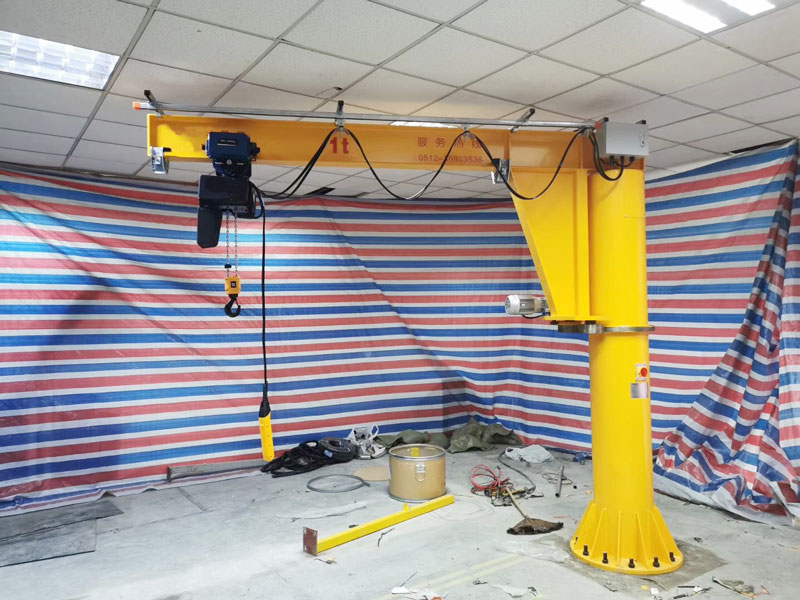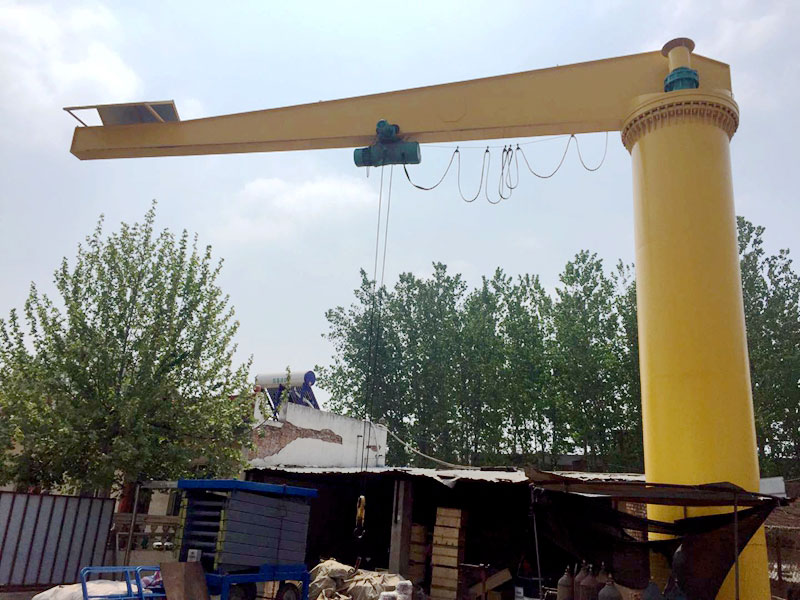Kren jib ialah kren kekuatan kerja yang ringan dan peralatan mengangkat stesen kerja ringan yang praktikal. Ia mempunyai ciri-ciri kecekapan tinggi, penjimatan tenaga, penjimatan masalah, jejak kecil, dan operasi dan penyelenggaraan yang mudah. Amat sesuai untuk operasi pengangkatan jarak dekat, kerap digunakan dan intensif. Terutamanya terdiri daripada lajur, lengan berputar, lengan sokongan dan pengurang, angkat elektrik rantai, komponen elektrik, dll. Komponen utama kren jib biasanya termasuk:
Jib: Jib ialah lengan mendatar yang memanjang dari tiang menegak atau struktur sokongan. Ia menyediakan capaian dan kapasiti mengangkat kren. Jib biasanya diperbuat daripada keluli dan boleh berputar secara mendatar untuk menutup kawasan tertentu.
Tiang atau Struktur Sokongan: Tiang atau struktur sokongan memberikan kestabilan kepada kren angkat jib. Ia biasanya tiang atau tiang menegak yang dipasang dengan selamat ke tanah atau struktur sokongan. Tiang mungkin mempunyai ketinggian tetap atau boleh laras, bergantung pada reka bentuk kren.

Pengangkat: Pengangkat ialah mekanisme yang digunakan untuk mengangkat dan menurunkan beban. Ia biasanya dipasang pada jib dan boleh bergerak sepanjang jib. Pengangkat mungkin termasuk motor, gear, dan sistem dram atau rantai untuk mengangkat beban. Ia juga mungkin mempunyai kawalan untuk kedudukan tepat beban.
Troli: Troli ialah gerabak bergerak yang berjalan di sepanjang jib dan menyokong angkat. Ia membolehkan pengangkat bergerak secara mendatar sepanjang jib, memberikan fleksibiliti tambahan dalam meletakkan beban. Troli boleh dikendalikan secara manual atau dikuasakan oleh motor.
Counterweight: Sesetengah kren jib mungkin termasuk sistem counterweight untuk membantu mengimbangi beban dan mengurangkan tekanan pada kren. Pemberat pengimbang biasanya terletak di hujung jib yang bertentangan dari beban dan bergerak ke arah yang bertentangan untuk mengimbangi berat beban.

Sistem Kawalan: Kren jib dikawal menggunakan sistem kawalan yang membolehkan pengendali menggerakkan kren dan mengawal pergerakan mengangkat, menurunkan dan mendatar beban. Sistem kawalan mungkin termasuk butang, tuil atau peranti kawalan jauh.
Asas atau Asas: Jib kren memerlukan asas atau tapak yang stabil untuk menyokong tiang dan beban yang diangkat. Asas boleh menjadi pad konkrit atau sokongan keluli struktur, bergantung pada keperluan khusus kren.
Ini ialah komponen umum kren jib, tetapi penting untuk ambil perhatian bahawa jenis kren jib yang berbeza mungkin mempunyai variasi dalam reka bentuk dan ciri tambahan berdasarkan penggunaan yang dimaksudkan dan keperluan industri khusus.
